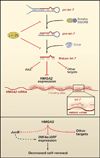HMGA2, microRNAs, and stem cell aging
- PMID: 19070572
- PMCID: PMC3725266
- DOI: 10.1016/j.cell.2008.11.026
HMGA2, microRNAs, and stem cell aging
Abstract
Mammalian aging results from a replicative decline in the function of somatic stem cells and other self-renewing cells. Recent studies (Monzen et al., 2008; Nishino et al., 2008; Sanna et al., 2008; Weedon et al., 2008) link a chromatin-associated protein, HMGA2, to development, height, and mouse stem cell aging during late fetal development and young adulthood.
Figures

Comment on
-
Hmga2 promotes neural stem cell self-renewal in young but not old mice by reducing p16Ink4a and p19Arf Expression.Cell. 2008 Oct 17;135(2):227-39. doi: 10.1016/j.cell.2008.09.017. Cell. 2008. PMID: 18957199 Free PMC article.
References
-
- Battista S, Fidanza V, Fedele M, Klein-Szanto AJ, Outwater E, Brunner H, Santoro M, Croce CM, Fusco A. Cancer Res. 1999;59:4793–4797. - PubMed
-
- Bussing I, Slack FJ, Grosshans H. Trends Mol. Med. 2008;14:400–409. - PubMed
-
- Fusco A, Fedele M. Nat. Rev. Cancer. 2007;7:899–910. - PubMed
-
- Gil J, Peters G. Nat. Rev. Mol. Cell Biol. 2006;7:667–677. - PubMed
Publication types
MeSH terms
Substances
Grants and funding
LinkOut - more resources
Full Text Sources
Other Literature Sources
Medical

